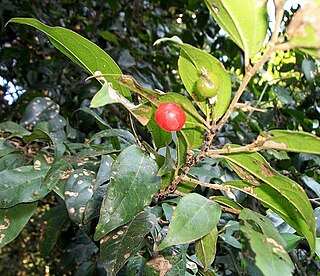
Boswellia is a genus of trees in the order Sapindales, known for its fragrant resin. The biblical incense frankincense is an extract from the resin of the tree Boswellia sacra, and is now produced also from B. frereana.

Chlorophytum, is a genus of almost 200 species of evergreen perennial flowering plants in the century plant subfamily within the asparagus family. The plants are native to the tropical and subtropical regions of Africa, Australia, and Asia.

Chlorophytum tuberosum is a species of flowering plant in the Asparagaceae family. It is one of several species known by the common name musli. It is native to parts of Africa and India. It has historical uses in Ayurveda.

Combretum padoides, the thicket bushwillow, occurs in the lowlands of tropical and south-eastern Africa. They grow in a range of habitats from muddy riverbanks to dry rocky hillsides. The mostly opposite oval leaves are carried on long slender branches. The trees or shrubs flower in profusion in mid-summer and the 4-winged fruits reach maturity from late summer to mid winter.

Allanblackia stuhlmannii is a species of flowering plant in the family Clusiaceae. It is found only in Tanzania.
Garcinia afzelii is a species of small to medium tree in the family Clusiaceae. It is found in Cameroon, Central African Republic, Gabon and Guinea. It is sometimes called "bitter kola", but this name properly refers to G. kola.
Afrothismia winkleri is a species of plant in the Burmanniaceae family. It is found in Cameroon, Nigeria, and possibly Uganda. Its natural habitat is subtropical or tropical moist lowland forests. It is threatened by habitat loss.
Amorphophallus preussii is a species of plant in the family Araceae. It is endemic to Cameroon. Its natural habitats are lowland tropical and subtropical moist broadleaf forests and subtropical and montane tropical and subtropical coniferous forests. It is a Vulnerable species threatened by habitat loss.
Anthurium gualeanum is a species of plant in the family Araceae. It is endemic to Ecuador. Its natural habitats are subtropical or tropical moist lowland forests and subtropical or tropical moist montane forests. It is threatened by habitat loss.
Anthurium rigidifolium is a species of plant in the family Araceae. It is endemic to Ecuador. Its natural habitat is subtropical or tropical moist montane forests. It is threatened by habitat loss.
Magnistipula conrauana is a species of plant in the family Chrysobalanaceae. It is endemic to Cameroon. Its natural habitats are subtropical or tropical moist lowland forests and subtropical or tropical moist montane forests. It is threatened by habitat loss.
Polyceratocarpus scheffleri is a species of plant in the Annonaceae family. It is endemic to Tanzania.
Trichoscypha bijuga is a species of plant in the family Anacardiaceae. It is found in Cameroon, Ivory Coast, Equatorial Guinea, Ghana, Guinea, and Liberia. Its natural habitat is subtropical or tropical moist lowland forests. It is threatened by habitat loss.
Uvariastrum zenkeri is a species of plant in the Annonaceae family. It is found in Cameroon and Nigeria. It is threatened by habitat loss.
Xanthosoma eggersii is a species of plant in the family Araceae. It is endemic to Ecuador. Its natural habitat is subtropical or tropical moist lowland forests. It is threatened by habitat loss.

Buchanania obovata is a small to medium-sized understorey tree in woodlands native to northern Australia, in particular in Arnhem Land in the Northern Territory. Common names include green plum and wild mango.

Celtis mildbraedii is a species of forest tree in the family Cannabaceae. It was previously assigned to the family Ulmaceae. These trees grow in limited areas of South Africa, Mozambique and Zimbabwe. They are also found in forested areas from West Africa to Sudan, DRC, Angola and Tanzania. Common names include natal white stinkwood, red-fruited white-stinkwood and natal elm. This species is more common in Tropical Africa than in Southern Africa.
Commiphora angolensis, also known as sand commiphora or sand corkwood, is a shrub species in the genus Commiphora growing mainly in Angola and Namibia.

Chlorophytum filipendulum is a species of flowering plant in the Asparagaceae family. It is native to a variety of habitats across large areas of Africa.
Gymnosiphon usambaricus is a species in the plant family Burmanniaceae. It is endangered due to habitat loss with an estimated 2500 mature individuals left. It is native to Kenya and Tanzania, and is found in the leaf litter in evergreen forests.









